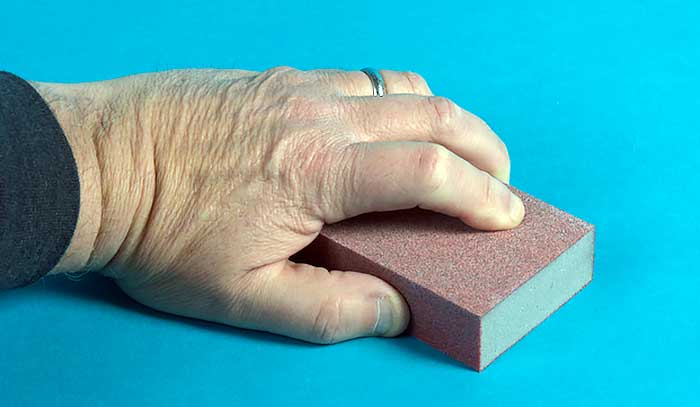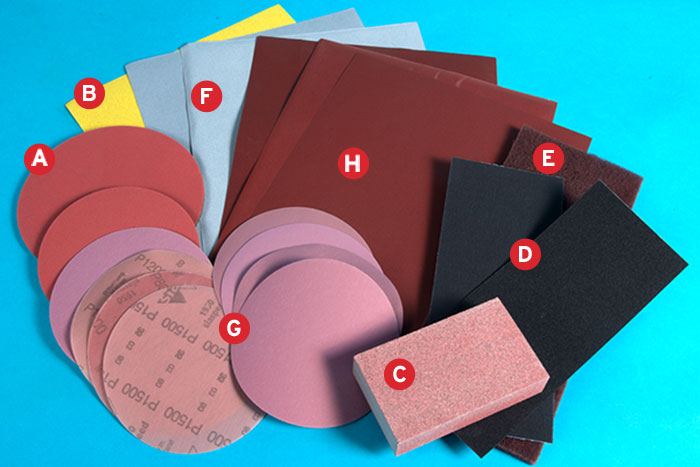Advertisement
Do any boat DIY project, and you're almost sure to use some sandpaper. Which sort you pick will depend on the job at hand.

Abrasives have many uses aboard, from removing paint and varnish to polishing out scratches in gelcoat. Sandpaper is an almost universally understood term; but sand, in fact, hasn't been used as an abrasive for many years. Picking the correct sandpaper is a little more complicated than simply popping into the local hardware store. Abrasive papers come in a plethora of types, grits, and sizes to suit both hand-sanding and power-tool applications, so it pays to know what to ask for. Buy the wrong stuff and you could be frustrated with the results. To help you make wise choices, we've put together this handy guide.
Tip
Grit Sizes
Look on the pack of any sheet of abrasive paper and you'll notice a number — 120, for example, or 180, or 220. This number refers to the grit size, the actual physical dimensions of each particle glued to the backing. The larger the number, the smaller the grit: An 80-grit paper would be used for the swift removal of material, whereas a 400-grit abrasive would be used for fine finishing. Grit sizes are universal, so a 120-grit from one manufacturer will be virtually identical to 120-grit paper from another. The coarser grits, from 24 up to about 80, are used for stock removal and will cut away at the surface very quickly. Grits from around 100 to 240 are best for general smoothing, while grits from 300 and above tend to fall more into the polishing arena.
Abrasive Types
There are several different and distinct types of abrasives (the actual material that's stuck onto the backing paper). Aluminum oxide is the most abundant, comes in a variety of different colors depending on the manufacturer, is available in a wide variety of grit sizes, and can be purchased in rolls or sheets for hand sanding or may be precut to suit many popular styles of sanding machines.
Silicon-carbide abrasives tend to be black or gray in color, are waterproof, and can be used wet or dry. Silicon carbide, very hard and long lasting, is ideal for the wet sanding of varnish or of paint between coats. When used wet, a slurry is formed that further speeds up the cutting process. Silicon-carbide abrasives can be purchased in very fine grades, ideal for sanding gelcoat before compounding and buffing.
Harder, and therefore longer lasting than aluminum oxide or silicon carbide, zirconia or ceramic abrasives have higher price tags and are unlikely to be available except through specialty retailers.

A. Aluminum-oxide foam-backed pads are ideal for sanding uneven or contoured surfaces. The finer grits, 500 and above, are great for gelcoat sanding before the compounding of badly oxidized surfaces.
B. Some aluminum-oxide papers have what's known as semi-friable grit. This essentially means that the grit breaks as it's used, constantly exposing new sharp edges and thus making the paper last longer.
C. Sanding sponges are the perfect solution for getting into crisp corners that would otherwise be difficult to sand with sheets or disc products. Use sanding sponges either wet or dry.
D. Emery cloth is ideal for sanding both ferrous and non-ferrous metals. One word of warning: Because the sanding residue will turn adjacent wood, paint, and gelcoat black, make sure to protect these surfaces.
E. Scotchbrite-type sanding cloths can be used wet or dry. They're best for sanding down rough surfaces and removing flaking paint and varnish.
F. Often black or blue, silicon-carbide paper is best for the wet intercoat sanding of paint and varnish. The use of water acts as a lubricant, which has the added advantage of keeping dust down.
G. For sanding large areas, circular discs, available with either hook-and-loop backing or a pressure-sensitive adhesive, are designed to be used on an orbital sander. Some discs have holes in them; when the sander is connected to a shop vacuum, dust is practically eliminated.
H. Aluminum-oxide sheets are perfect for sanding bare wood before a final coating is applied. They're available in grit sizes from 24, for fast removal of wood, to 1,500 and above, for the ultimate finish.
Open Coat Or Closed Coat?
Open coat and closed coat refer to how closely the grit is spaced and has nothing to do with the actual grit size. An open-coat paper is probably best for sanding paint and varnish surfaces — with a bigger gap between each of the abrasive crystals, it's less likely to clog up. On the other hand, because there's a greater number of grit crystals per square inch on closed-coat paper, it will most likely cut faster on harder materials, such as metals, as there are more pieces of grit to do the actual work of abrading the surface.
